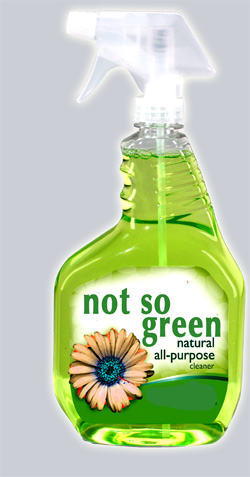 by: Dr. Mamak Shakib
by: Dr. Mamak Shakib
While you may not be cleaning your room or dorm right now, it is a good idea to know if your cleaning products are safe to use. After all, the cleaning day is just around the corner! The typical American home contains 3-10 gallons of toxic materials. Unbelievable, right?!!! The good news is that the Wellness Revolution has begun and people realize that they simply cannot trust what they hear on commercial TV and radio - that despite all the money spent on health care, we are becoming sicker and sicker as a society.
Environmental factors play a major role in our health, thus discussing cleaning products is in order (that's right, stop complaining and take control!) When it comes to cleaning products, the first thing to note is that the terms “green” and “natural” do not always equate safety and that they are simple marketing techniques to manipulate and sell the products to the general public.
An interesting, yet disgusting trick is that a product may claim to be natural, safe, biodegradable or green, but this only refers to the repackaging of the product because it is in a biodegradable container. This has nothing to do with the actual cleaning product and is a mischievous way of misleading the consumer.
For the chemistry-savvy reader, here is a list of hazardous ingredients found in the most common cleaning products. Petroleum distillates such as benzene or 1,4 dioxane are both cancer causing. 1,4 dioxane can damage the kidneys, nervous system and respiratory system. Phosphates cause algae proliferation in bodies of water leading to the destruction of marine life, while nonylphenol ethoxylates can cause reproductive defects and damage to the liver and kidneys. The list continues with phthalates, which are particularly harmful to male sperm and can cause reproductive defects in boys. Then there's 1,4-dichlorobenzene, an ingredient that irritates the nose and throat and causes dizziness and asthma. Don't forget glycol ethers, ammonia, chlorine, and ethanolamines. Natural chemicals that cause allergic reactions can include limonene (citrus-based oil), pine oil, and coconut diethanolamide.
The simple rule to remember is that if you cannot eat what is listed as the constituent ingredient, then you should not be using it, period. If you feel distrustful and cheated, join the crowd. Let’s turn the negative feeling into something positive. How about taking control? In this case, my suggestion is to start from scratch and make your own cleaning products. Before you disregard this, read on to see how easy and inexpensive it is to win this battle. After all, you should know that everything of value is a pursuit and health does not come to you, but from you.
Here’s a simple starter list of what you need to make your own natural cleaning products: baking soda, white vinegar, lemon juice, hydrogen peroxide, liquid castile soap, organic essential oils (which are optional), mixing bowls, spray bottles and micro fiber cloths. Vinegar combined with hydrogen peroxide is a great disinfectant. To clean mirrors and windows add a quarter-cup of white vinegar per quart of water. Add a few drops of liquid dish soap to the mixture if windows or mirrors are really dirty. For air fresheners, use therapeutic 100% essential oils (not fragrance oils). To learn about other cleaning product recipes, email me at Health Matters.
Dr. Mamak Shakib is the host of Health Matters which airs on alternating Wednesdays from 8-9 a.m.on KUCI. She is the clinic director of Irvine Spine and Wellness Center.
Share
|
|

